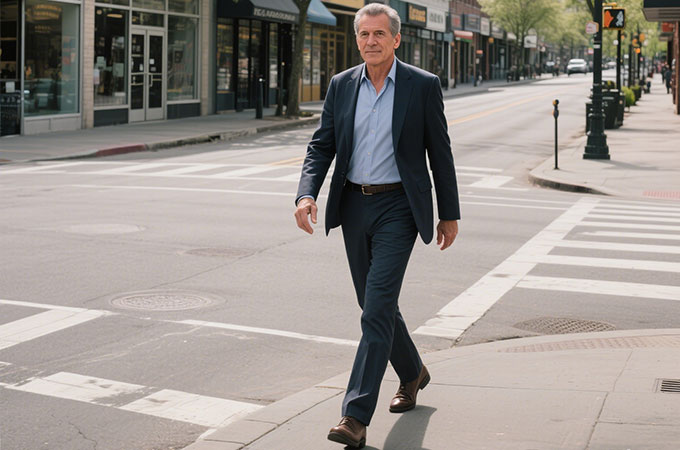Imagine this: a simple habit, something you do every day without much thought, could be the key to a longer, healthier life. No fancy diets, no expensive gym memberships—just the way you walk. A groundbreaking study has revealed that people who walk briskly may have a biological age up to 16 years younger than their slower-strolling peers by the time they reach middle or old age. This isn’t just about getting from point A to point B; it’s about how your walking speed might be a window into your longevity. Let’s dive into this fascinating discovery and explore why picking up the pace could be one of the simplest secrets to a longer life.
The Science Behind the Stride
A recent study published in Nature Communications, analyzing data from over 405,000 individuals, uncovered a striking connection between walking speed and biological aging. Researchers found that those who consistently walk at a brisk pace—think of a purposeful, energetic stride—tend to have younger biological markers, such as healthier cells and organs, compared to those who amble along more slowly. By middle and older age, the difference is staggering: fast walkers appear, biologically, about 16 years younger than their slow-walking counterparts.
But what does “biological age” mean? Unlike your chronological age (the number of candles on your birthday cake), biological age reflects how well your body is holding up at the cellular level. It’s influenced by factors like inflammation, DNA repair, and the length of your telomeres—those protective caps at the ends of your chromosomes that shorten with age. The study suggests that brisk walking may help slow down this cellular aging process, keeping your body “younger” for longer.
Why does walking speed matter? It’s not just about fitness. A faster pace often signals better cardiovascular health, stronger muscles, and even sharper cognitive function. Walking briskly gets your heart pumping, improves circulation, and engages multiple muscle groups, all of which contribute to overall vitality. Think of it as a daily mini-workout that doesn’t require a gym membership or special equipment—just a good pair of shoes and a little motivation.
A Global Perspective: Walking Among the Long-Lived
This research aligns with observations of some of the world’s longest-living populations, often found in so-called “Blue Zones” like Okinawa, Japan, or Sardinia, Italy. These communities share habits that promote longevity, and one common thread is staying active in natural, everyday ways. Many centenarians in these regions don’t hit the treadmill or lift weights—they walk, and they walk a lot. Whether it’s trekking up hilly terrain to tend to gardens or strolling to the market, their active lifestyles keep them moving at a lively pace well into their later years.
Walking speed isn’t the only habit of long-lived people, but it’s a key piece of the puzzle. Alongside other practices like eating plant-based diets, fostering strong social connections, and managing stress, a brisk walking habit stands out as an accessible, low-effort way to boost health. The Nature Communications study adds a scientific stamp to what these communities have intuitively practiced for generations: moving with purpose can add years to your life.
How to Walk Your Way to a Longer Life
Ready to put this science into action? You don’t need to start sprinting, but picking up your pace can make a difference. Here’s a simple guide to incorporate brisk walking into your daily routine:
- Find Your Pace: A brisk walk means moving at a speed where you’re slightly out of breath but can still hold a conversation—around 3 to 4 miles per hour (or about 100 to 130 steps per minute). Try counting your steps for 15 seconds and multiply by 4 to gauge your pace.
- Start Small: If you’re not used to walking quickly, begin with short bursts. For example, walk briskly for 5 minutes during your usual stroll, then slow down for a minute or two, and repeat. Gradually increase the duration of your brisk intervals.
- Make It a Habit: Aim for at least 20 to 30 minutes of brisk walking most days of the week. You can break it up into smaller chunks—say, a 10-minute walk to the store and back. The key is consistency.
- Mix It Up: Add variety by walking on different terrains, like hills or trails, to challenge your muscles and keep things interesting. Listening to upbeat music or a podcast can also make the time fly.
- Track Your Progress: Use a fitness tracker or smartphone app to monitor your walking speed and distance. Seeing your improvement can be a great motivator.
- Stay Safe: Wear comfortable, supportive shoes to prevent injury, and choose well-lit, safe routes. If you have health concerns, check with your doctor before ramping up your activity.
Why This Matters Now
In a world where we’re constantly bombarded with complex health advice—keto this, intermittent fasting that—the simplicity of walking faster is refreshing. It’s a habit anyone can adopt, regardless of age, fitness level, or budget. Plus, it’s not just about living longer; it’s about living better. A brisk walk can lift your mood, clear your mind, and even spark creativity (ever notice how your best ideas come while you’re moving?).
The Nature Communications study is a wake-up call to pay attention to how we move through the world. Walking isn’t just a way to get around—it’s a powerful tool to shape our health and future. So, the next time you lace up your shoes, try picking up the pace. Your body, and those extra years, will thank you.
This research was published in Nature Communications and draws on data from a comprehensive study of over 405,000 individuals. We extend our gratitude to the researchers for shedding light on such an accessible yet profound health insight.

